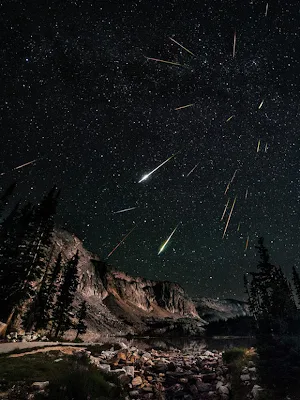Δυο
μετέωρα Περσειδών πάνω από τους βράχους των Μετεώρων στην Καλαμπάκα. The two
bright meteors flashing through this night skyscape from August 7 are part of
the ongoing Perseid meteor shower. In the direction indicated by both colorful
streaks, the shower's radiant in the eponymous constellation Perseus is at the
upper right. North star Polaris, near the center of all the short, arcing star
trails is at the upper left. But also named for its pose against the sky, the
monastery built on the daunting sandstone cliffs in the foreground is part of
Meteora. A World Heritage site, Meteora is a historic complex of lofty
monasteries located near Kalabaka in central Greece. Image Credit & Copyright: Babak
Tafreshi (TWAN)
Αργά
το βράδυ της Δευτέρας 12 Αυγούστου, στον νυχτερινό ουρανό του βορείου
ημισφαιρίου -και της Ελλάδας- θα αποκορυφωθεί για μια ακόμα εντυπωσιακή βροχή
από «πεφταστέρια», τους διάττοντες Περσείδες. Τόσο το βράδυ της προηγούμενης
μέρας (Κυριακή), όσο και της επόμενης (Τρίτη) θα πρέπει επίσης να αναμένεται
αυξημένη πτώση μετεώρων.
Night sky watcher
David Kingham took this photo of the Perseid meteor shower from Snowy Range in
Wyoming on August 12, 2012. Credit:
David Kingham/DavidKinghamPhotograph
Όσοι
ξενυχτήσουν, θα έχουν την ευκαιρία -εφόσον ο καιρός κατά τόπους το επιτρέψει-
να δουν το θεαματικό αστρονομικό φαινόμενο, που μπορεί να φθάσει έως τα 100
μετέωρα ανά ώρα. Με δεδομένο ότι το φεγγάρι δεν είναι «γεμάτο», ο ουρανός θα
είναι αρκετά σκοτεινός και κατάλληλος για τις παρατηρήσεις των μετεώρων.
Οι
Περσείδες θεωρούνται μια από τις πιο εντυπωσιακές βροχές διαττόντων του έτους,
καθώς τα «πεφταστέρια» τους είναι κατεξοχήν γρήγορα και φωτεινά, συχνά με
μακριές πύρινες «ουρές».
Sunday and Monday,
August 11 and 12, 2013, all night. The peak of the Perseid meteor shower,
usually the best in the year, occurs in the middle of the day on Monday August
12, so both the night before and the night after will both be good to observe
meteors. Usually meteors are more frequent after local midnight, around 1 a.m.
local daylight saving time. The crescent moon setting before 11 p.m. won’t
interfere with the meteors, which are best observed from a dark country
location. Credit: Starry Night Software
Oι Περσείδες δεν είναι τίποτε άλλο από μικρά
απομεινάρια, μέχρι και σε μορφή σκόνης, του κομήτη Σουίφτ Τατλ, τα οποία
συναντά η Γη μία φορά τον χρόνο γύρω στις αρχές του Αυγούστου. Όταν μπαίνουν
στην ατμόσφαιρα της Γης τα σωματίδια αναφλέγονται σε ύψος περίπου 100
χιλιομέτρων και σχηματίζουν μια φωτεινή σφαίρα που κινείται με την ιλιγγιώδη
ταχύτητα των 200.000 χιλιομέτρων την ώρα. Κατά τη διάρκεια της εισόδου τους
στην ατμόσφαιρα, αφήνουν πίσω τους μια “ουρά” που ονομάζεται διάττοντας
αστέρας, μετέωρο ή πεφταστέρι, και φαίνεται από τη Γη με γυμνό μάτι.
Ονομάζονται Περσείδες, επειδή το ακτινοβόλο σημείο τους προβάλλεται στον
αστερισμό του Περσέα, φαίνεται δηλαδή ότι έρχονται από την κατεύθυνση αυτή.




Δεν υπάρχουν σχόλια:
Δημοσίευση σχολίου